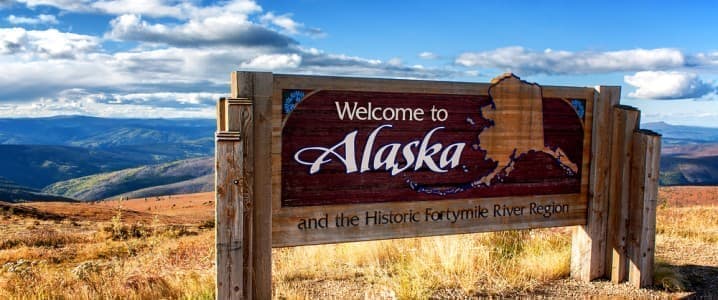Business
Trump Administration Advances Plans to Open 82% of Alaska’s Reserve

The Trump administration is moving forward with plans to open up 82% of Alaska’s National Petroleum Reserve for drilling, a significant shift in U.S. energy policy. This decision comes as President Donald Trump continues to advocate for increased oil and gas production on federal lands, despite growing concerns about environmental impacts.
During a tour of the Prudhoe Bay oilfield in June, U.S. Energy Secretary Chris Wright expressed ambitions to double the volume of crude oil flowing through Alaska’s pipelines. He stated, “Let’s double oil production, build the big, beautiful twin, and we will help energise the world and strengthen our country and families.” This goal aligns with the administration’s broader strategy to enhance domestic energy production.
In a notable development, the Department of the Interior announced plans to repeal restrictions imposed during the Biden administration that limited drilling in the reserve, which is designated as a protected wildlife area. The agency argued that these restrictions were inconsistent with the 1976 Naval Petroleum Reserves Production Act, which permits oil and gas leasing. Interior Secretary Doug Burgum noted, “Congress was clear: the National Petroleum Reserve in Alaska was set aside to support America’s energy security through responsible development.”
Public feedback on the proposed changes garnered significant attention, with approximately 250,000 responses collected during the commentary period. In July, the Interior Department confirmed it would revoke three documents aimed at curbing drilling, marking a key victory for the Trump administration, which has been pushing for increased drilling over the past seven months.
The debate surrounding drilling in Alaska is complex. The Biden administration initially implemented restrictions to prioritize traditional Indigenous practices and protect habitats for wildlife, including polar bears and caribou, across approximately 3 million acres of the 23-million-acre reserve. Under previous administrations, around half of the reserve had already been shielded from oil development.
Supporters of increased drilling argue that Alaska’s oil and gas sector has been a critical source of revenue for the state, funding about half of the state government. The Alaska Permanent Fund, which distributes annual dividends to eligible residents based on oil royalty revenue, has made oil operations popular among many Alaskans. The state’s North Slope contains some of the largest natural gas fields in the United States, according to the U.S. Energy Information Administration.
Despite the economic benefits, environmentalists and Indigenous communities express deep concerns regarding potential damage to ecosystems and human health. The International Energy Agency has warned that no new oil and gas fields should be developed if the world hopes to meet its climate goals. Opponents argue that new drilling threatens Arctic wildlife and undermines the rights of Alaska Natives.
The Willow project, approved by the Biden administration and currently under construction, illustrates the long-term environmental impact of oil projects. Expected to be operational for over 30 years, it raises questions about the sustainability of fossil fuel development. Andy Moderow, senior director of policy at the Alaska Wilderness League, cautioned, “We’re not talking about oil next year. We’re talking about oil in 2050 and 2060 and beyond when we need to move past it.”
While new oil projects may offer immediate economic benefits, they could also jeopardize the health and livelihoods of Indigenous communities and wildlife. As global discussions intensify around transitioning to greener energy sources, the rollback of environmental protections in Alaska highlights the tensions between economic development and climate action. The future of drilling in this vulnerable ecosystem remains a contentious issue that will shape the region’s environmental and economic landscape for years to come.
-

 World5 months ago
World5 months agoSBI Announces QIP Floor Price at ₹811.05 Per Share
-

 Lifestyle5 months ago
Lifestyle5 months agoCept Unveils ₹3.1 Crore Urban Mobility Plan for Sustainable Growth
-

 Science4 months ago
Science4 months agoNew Blood Group Discovered in South Indian Woman at Rotary Centre
-

 World5 months ago
World5 months agoTorrential Rains Cause Flash Flooding in New York and New Jersey
-

 Top Stories5 months ago
Top Stories5 months agoKonkani Cultural Organisation to Host Pearl Jubilee in Abu Dhabi
-

 Sports4 months ago
Sports4 months agoBroad Advocates for Bowling Change Ahead of Final Test Against India
-

 Science5 months ago
Science5 months agoNothing Headphone 1 Review: A Bold Contender in Audio Design
-

 Top Stories5 months ago
Top Stories5 months agoAir India Crash Investigation Highlights Boeing Fuel Switch Concerns
-

 Business5 months ago
Business5 months agoIndian Stock Market Rebounds: Sensex and Nifty Rise After Four-Day Decline
-

 Sports4 months ago
Sports4 months agoCristian Totti Retires at 19: Pressure of Fame Takes Toll
-

 Politics5 months ago
Politics5 months agoAbandoned Doberman Finds New Home After Journey to Prague
-

 Top Stories5 months ago
Top Stories5 months agoPatna Bank Manager Abhishek Varun Found Dead in Well









